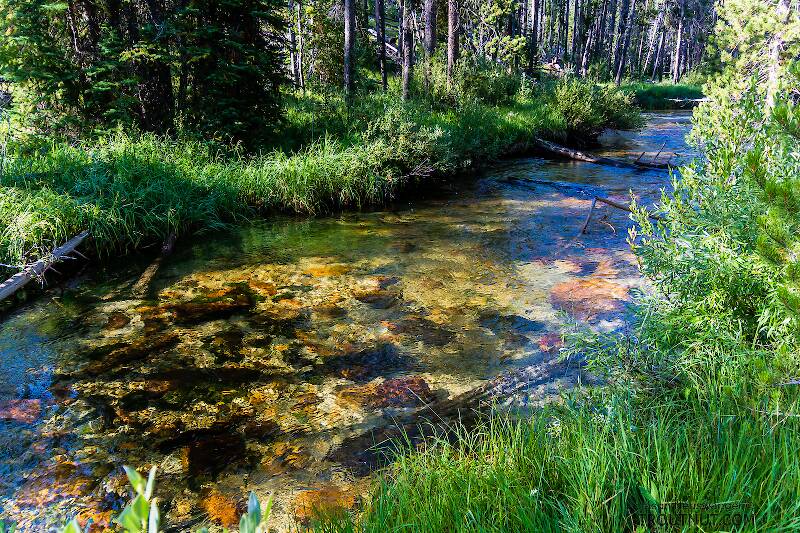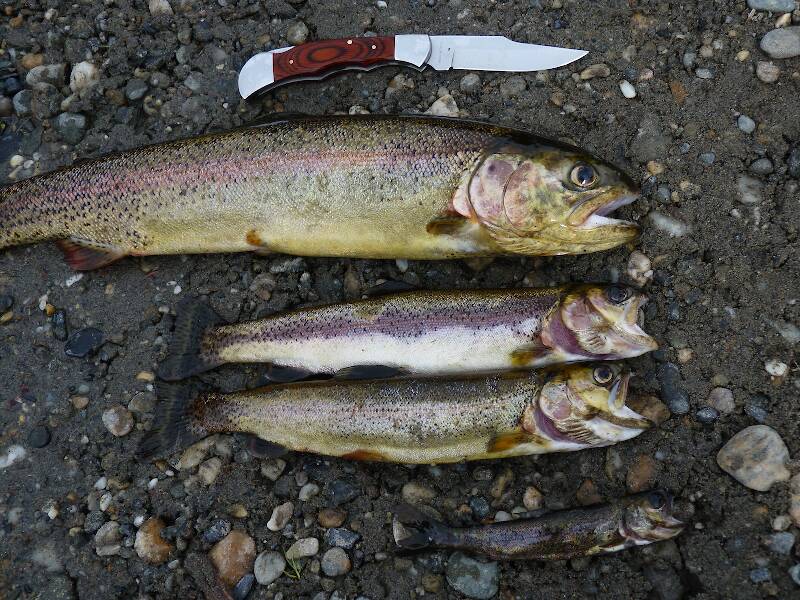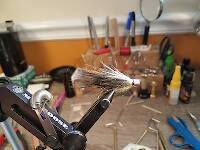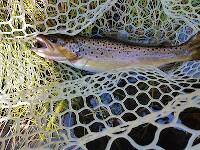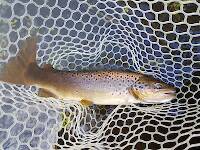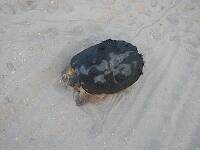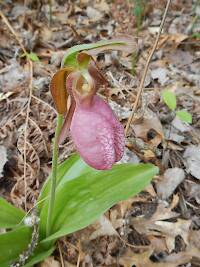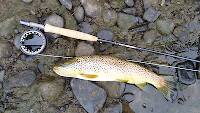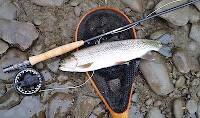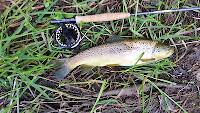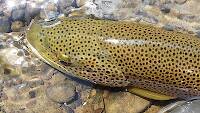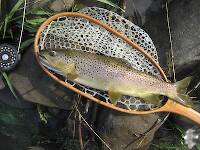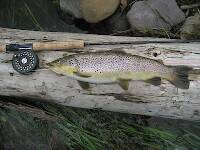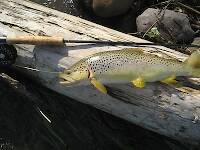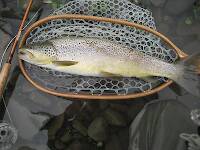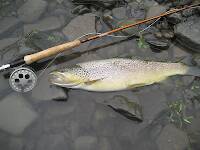
Salmonflies
Pteronarcys californica
The giant Salmonflies of the Western mountains are legendary for their proclivity to elicit consistent dry-fly action and ferocious strikes.
Featured on the forum


Troutnut is a project started in 2003 by salmonid ecologist Jason "Troutnut" Neuswanger to help anglers and
fly tyers unabashedly embrace the entomological side of the sport. Learn more about Troutnut or
support the project for an enhanced experience here.
Strmanglr on Nov 28, 2011November 28th, 2011, 6:53 am EST
Anyone using crayfish flies regularly with success? I have read Fly Fishermans Guide to Michigan by Bedford and so many streams he talks of crayfish being one of the main staples of a browns diet. I've never pursued fishing with crayfish.
Sayfu
Posts: 560
Posts: 560
Sayfu on Nov 28, 2011November 28th, 2011, 7:00 am EST
Remember, a crayfish swims, scoots, backwards, and stays down. I'd say a brown, or that rusty colored brown, maybe they call it pumpkin color....a woolly bugger dead drifted deep, and taken could have been taken for a crayfish.
FredH on Nov 28, 2011November 28th, 2011, 8:10 am EST
Crawfish are great prey for big fish and there are many flies to mimic them. You should find out what size and color are abundent where you fish before deciding on a fly though. There are 31 species in La. alone . Although a single pattern could be tied in differnt colors and sizes to mimic most of them , some patterns will work better than others. Experiment and let the fish tell you what will work.
Fred
Fred
Sayfu
Posts: 560
Posts: 560
Sayfu on Nov 28, 2011November 28th, 2011, 2:43 pm EST
Isn't the very classy steelhead pattern, the General Practitioner, a crawfish pattern? I tied a variation of those up once with black bucktail spayed out behind like claws I think they technically represented. Fished on a sink-tip and fished down and across the pattern would ride head down, and the splayed claws would wobble up, and cross current. Gets me excited just posting this!
Entoman on Nov 28, 2011November 28th, 2011, 3:19 pm EST
Hi Jere -
The GP was originated as a prawn imitation. A purple version is my favorite Winter steelhead fly as long as the water is clear. Come to think of it though, you are right that it would make a good crawdad imitation. Most studies I've seen mention only the juveniles as being important trout food. The big guys are just too nasty I suppose.
Their imitations are quite popular on the Truckee. I have had good luck there over the years with a burnt orange & olive B.H. woolly bugger in size 10, either under an indicator or high-sticked in the pockets.
Regards,
Kurt
The GP was originated as a prawn imitation. A purple version is my favorite Winter steelhead fly as long as the water is clear. Come to think of it though, you are right that it would make a good crawdad imitation. Most studies I've seen mention only the juveniles as being important trout food. The big guys are just too nasty I suppose.
Their imitations are quite popular on the Truckee. I have had good luck there over the years with a burnt orange & olive B.H. woolly bugger in size 10, either under an indicator or high-sticked in the pockets.
Regards,
Kurt
"It's not that I find fishing so important, it's just that I find all other endeavors of Man equally unimportant... And not nearly as much fun!" Robert Traver, Anatomy of a Fisherman
Sayfu
Posts: 560
Posts: 560
Sayfu on Nov 29, 2011November 29th, 2011, 4:35 am EST
Kurt..GP as an original prawn comes back to me now. Can you view this video? A U-tube that is not short, but incredible video, fabulous scenery, big native steelhead, and a great looking river. I can do that! I dream a lot about that stuff. Hope you can view it. I think the first fly she ties on is a GP..maybe a tube fly GP. http://vimeo.com/17973045
Strmanglr on Nov 29, 2011November 29th, 2011, 6:56 am EST
Wow! That was awesome, nice video, thanks for posting the link.
The first fly she had in the vise was a tube fly.
"Most studies I've seen mention only the juveniles as being important trout food. The big guys are just too nasty I suppose."
I would think that would be due to a softer shell in a smaller crayfish to a point. I've heard if you can fish crayfish when they molting it's big time action. I believe they take on a different color before and after the molt. Creating a fly in this color would seem to be beneficial.
The first fly she had in the vise was a tube fly.
"Most studies I've seen mention only the juveniles as being important trout food. The big guys are just too nasty I suppose."
I would think that would be due to a softer shell in a smaller crayfish to a point. I've heard if you can fish crayfish when they molting it's big time action. I believe they take on a different color before and after the molt. Creating a fly in this color would seem to be beneficial.
Oldredbarn on Nov 29, 2011November 29th, 2011, 6:57 am EST
Anyone using crayfish flies regularly with success? I have read Fly Fishermans Guide to Michigan by Bedford and so many streams he talks of crayfish being one of the main staples of a browns diet. I've never pursued fishing with crayfish.
Strmanglr,
This is a very interesting question. I've fished here in Michigan pretty much all my life, save the first 9 years in Virginia, and crayfish are definitely important with one disclaimer...When they are present.
When I was a youngster and spending my summers on my grandmother's 40 over by Marion I fished a small feeder creek to the Muskegon called the Middle Branch. It is loaded with crayfish, especially in town near a dam they have there that forms a small impoundment behind it. This skinny river is full of rather large Browns...
I read an article years back written by someone who was concerned about the decline in Browns in the Pere Marquette and they mentioned my stream as actually holding more fish than the PM on a relative basis...I wasn't too unhappy with the fella since I know that, for the most part, these old lunkers spend most of their days up under under-cut banks and come out at night and suck down a few crayfish and are hiding again by dawn. Also, this stream is so small it is nearly impossible to fish it and not spook these brutes...Besides casting in a tunnel of tag alders.
I have heard of others pulling nice fish from this stream, other than myself, but according to the DNR boys I've chatted with over this way over the years, it's usually guys throwing hardware or bait. Since I've been told that I'm somehow related to everyone in Oceola Co they are probably cousins from the less enlightened side of the family. :) Not fly-rodders in other words.
Now I have spent time around the Au Sable up near Grayling for decades and have yet to spook a single crayfish that I can remember. Folks tell me that they are there for sure but I have yet to see one. I spend a good deal of time digging around the stream bed and still no luck.
Maybe someone here with more of a biology background can refute or confirm my observation, but I think my lack of seeing them has to do with water temp and habitat in general. Generally the areas I fish on the Au Sable are cobble bottom and cold. Maybe in pockets where the habitat is more to their liking there would be more...(?) I haven't heard of too many anglers fishing with crayfish patterns there.
I agree though with the writer of the article that they are important when they are around. They would account for a good deal of protein when available. I agree with Kurt as well when he hints that there are periods in a crayfishes life when they are more vunerable to predation.
In the bass rivers I fish in Michigan, on the other hand, you shouldn't fish without some sort of crayfish pattern...I have caught smallies with crayfish stuck in their gullets...One that I'll always remember actually hit my damselfly nymph and had a whole sorry looking crayfish stuck there. I was removing the hook when I thought something looked odd and I looked in the fishes mouth to see the crayfish looking back at me..."Hey mister...Could you do a fella a favor?!" :)
Joe Cornwall of Ohio has written a wonderful small book on warm water fly fishing...The following link is to a pattern he ties called the "Mixed Media"...He has a nice explanation in that book about the life-cycle of the crayfish and why and when he uses different sizes etc.
http://www.flyfishohio.com/Mixed_Media.htm
Just one more thing...I have read elsewhere that trout eat more aquatic insects than crayfish, but when they can they no-doubt will eat them.
Good question, though!
Spence
You and I were composing posts at the same time and yes to the following:
I would think that would be due to a softer shell in a smaller crayfish to a point. I've heard if you can fish crayfish when they molting it's big time action. I believe they take on a different color before and after the molt. Creating a fly in this color would seem to be beneficial.
"Even when my best efforts fail it's a satisfying challenge, and that, after all, is the essence of fly fishing." -Chauncy Lively
"Envy not the man who lives beside the river, but the man the river flows through." Joseph T Heywood
"Envy not the man who lives beside the river, but the man the river flows through." Joseph T Heywood
Oldredbarn on Nov 29, 2011November 29th, 2011, 7:40 am EST
Sayfu,
By-the-way...Nice video. Now there is a woman after my own heart...She ties her own flies, casts with authority, and palm drags those big steelies in! She doesn't live in a half bad place either. I've always been attracted to independent women...To my detriment...:) I'm pretty good at knowing when to duck as a result...;)
Spence
By-the-way...Nice video. Now there is a woman after my own heart...She ties her own flies, casts with authority, and palm drags those big steelies in! She doesn't live in a half bad place either. I've always been attracted to independent women...To my detriment...:) I'm pretty good at knowing when to duck as a result...;)
Spence
"Even when my best efforts fail it's a satisfying challenge, and that, after all, is the essence of fly fishing." -Chauncy Lively
"Envy not the man who lives beside the river, but the man the river flows through." Joseph T Heywood
"Envy not the man who lives beside the river, but the man the river flows through." Joseph T Heywood
Entoman on Nov 29, 2011November 29th, 2011, 9:25 am EST
Jere - Great video, thanks for sharing. I've had the good fortune to be able to do quite a bit of it and it truly is the ultimate. BTW - Spey is the way.
Spence - It's been my experience that they love cobble and cold water. Perhaps there's other biological reasons why you don't find them in large numbers (or at all).
Strmanglr - I think it has more to do with their behavior and population mix. The big ones are pretty secretive and when challenged show those impressive claws pretty quickly. Also, for every large one there's hundreds of little ones at certain times of the year and unlike the big ones, there is evidence that they frequently enter the benthic drift. On the Truckee for example, their imitations take the place of stonefly nymphs for popular searching flies. Sizes 12 to 8 with 2X or 3x long shanks are by far the most effective and popular. A lot of them are tied on little jig hooks to maintain a horizontal drift.
Regards,
Kurt
Spence - It's been my experience that they love cobble and cold water. Perhaps there's other biological reasons why you don't find them in large numbers (or at all).
Strmanglr - I think it has more to do with their behavior and population mix. The big ones are pretty secretive and when challenged show those impressive claws pretty quickly. Also, for every large one there's hundreds of little ones at certain times of the year and unlike the big ones, there is evidence that they frequently enter the benthic drift. On the Truckee for example, their imitations take the place of stonefly nymphs for popular searching flies. Sizes 12 to 8 with 2X or 3x long shanks are by far the most effective and popular. A lot of them are tied on little jig hooks to maintain a horizontal drift.
Regards,
Kurt
"It's not that I find fishing so important, it's just that I find all other endeavors of Man equally unimportant... And not nearly as much fun!" Robert Traver, Anatomy of a Fisherman
PaulRoberts on Nov 29, 2011November 29th, 2011, 1:31 pm EST
The reason hardware guys catch the bigger browns is bc those bigger fish are predacious piscivores and "crustacivores".
The key to a crayfish mimic is action, more than anything else. If you can handle a jig on your fly rig, you get the idea of what is most often needed. Next are the contexts in which trout are expecting to see crayfish:
1).Spring migrations (should be an autumn one too but I have no experience there). A key time is in spring as water temps break 50F, when craws leave winter quarters in slack eddies and pool bottoms for the sunlit riffles and shorelines. This just happens to coincide with first prime insect hatch-matching opportunities most ff's don't want to miss; Another reason the hardware guys score on the bigger fish. One spring day back East I met a hardware angler along a crayfish-rich stream who had a creel full of good browns with notably distended bellies. After some chatting I asked if I could check the stomachs of some, and they were packed with craws. His largest, a 16"er, had 9 adult crayfish in it.
2).Summer in riffles with a good (heavily weighted with hook riding up) crawfish pattern to take advantage of the annual hatch of youngsters. If there are lots of young craws, dead-drifting can work.
3).At night, when craws are out and about, fishing across current.
If you really want to know whether there are crayfish in your stream, walk the bank on a summer night observing the shallows with a strong flashlight.
The key to a crayfish mimic is action, more than anything else. If you can handle a jig on your fly rig, you get the idea of what is most often needed. Next are the contexts in which trout are expecting to see crayfish:
1).Spring migrations (should be an autumn one too but I have no experience there). A key time is in spring as water temps break 50F, when craws leave winter quarters in slack eddies and pool bottoms for the sunlit riffles and shorelines. This just happens to coincide with first prime insect hatch-matching opportunities most ff's don't want to miss; Another reason the hardware guys score on the bigger fish. One spring day back East I met a hardware angler along a crayfish-rich stream who had a creel full of good browns with notably distended bellies. After some chatting I asked if I could check the stomachs of some, and they were packed with craws. His largest, a 16"er, had 9 adult crayfish in it.
2).Summer in riffles with a good (heavily weighted with hook riding up) crawfish pattern to take advantage of the annual hatch of youngsters. If there are lots of young craws, dead-drifting can work.
3).At night, when craws are out and about, fishing across current.
If you really want to know whether there are crayfish in your stream, walk the bank on a summer night observing the shallows with a strong flashlight.
PaulRoberts on Nov 29, 2011November 29th, 2011, 1:50 pm EST
Wonderful vid. Just wonderful. Except...great guitar riffs, but...on a steelhead river?? I want that kind of noise cleared from my head when I'm out there.
Entoman on Nov 29, 2011November 29th, 2011, 6:11 pm EST
I agree, Paul. What's wrong with the sound of running water, wind in the trees, birds chirping, or the occasional screech of a hawk. No better score possible.
Since we are critiquing - Using only the Snap-T cast was mentioned. For river left with an upstream or neutral breeze, it's an excellent choice. For the rest it's either impossible to execute or downright dangerous.
Since we are critiquing - Using only the Snap-T cast was mentioned. For river left with an upstream or neutral breeze, it's an excellent choice. For the rest it's either impossible to execute or downright dangerous.
"It's not that I find fishing so important, it's just that I find all other endeavors of Man equally unimportant... And not nearly as much fun!" Robert Traver, Anatomy of a Fisherman
Oldredbarn on Nov 29, 2011November 29th, 2011, 6:40 pm EST
Wonderful vid. Just wonderful. Except...great guitar riffs, but...on a steelhead river?? I want that kind of noise cleared from my head when I'm out there.
This is funny Paul...I watched at work in the office with the sound off...I didn't want the boss, my wife, to know I was watching another woman fishing instead of doing my job...:) Mums the word boys! So, I didn't hear any guitar.
The stream I mentioned above near my grandmother's place was a paradise for a young boy who tended toward solitude and had endured his parent's splitting up...Crayfish, frogs, hoppers flying everywhere with each step in the tall grass along the banks...Dragonflies and swooping Martins and Barn Swallows...An occassional deer crossing the stream... My own personal university and play-ground...When I made it back to the house after day long hikes and fishing trips I slept like a stone after grandma made me eat something and patiently sat there and listened to her grandson, over excited, explain it all to her.
When I became a vego at 16 and snuck up for visits and some fishing she would always ask anyone who would listen, "What do you think of a boy who spends all day on the stream and he doesn't even bring his poor grandmother a nice little brook trout?!" :)
Thanks for the crayfish info.
Spence
"Even when my best efforts fail it's a satisfying challenge, and that, after all, is the essence of fly fishing." -Chauncy Lively
"Envy not the man who lives beside the river, but the man the river flows through." Joseph T Heywood
"Envy not the man who lives beside the river, but the man the river flows through." Joseph T Heywood
Entoman on Nov 29, 2011November 29th, 2011, 7:41 pm EST
BTW - Excellent info on the crayfish, Paul. Come to think of it, on several rivers I fish that don't have the big Salmonflys to tumble, I'll fish a couple of impressionistic flies that could be taken for sculpin or crayfish during run-off spates, inclimate weather (or curses, I'm on the river early or late with no bugs hatching). Big zonkers and wooly buggers would work just as well, but figuring the fish have seen those patterns enough, I throw these at 'em a lot of the time. I like to either swing them deep or use the brooks method in the deep runs. I've never liked the anatomically correct designs of big cray fish (their lack of success, not because of looks) and don't consider the flies below to be imitations. But looking at them makes me think. Hmmm...
This one is a fly I call "Creature". It's basically a knock-off of Cutter's "Goblin" (which is a wooly bugger with a zonker wing added). This color combination has been pretty good for Montana browns in the Fall. They love yellow and brown for some reason. For the Sierra's I like black w/ an orange wing when the rivers are in spate (in deference to Cutter, who's on to something with this color combo). As the rivers clear-up I like Burnt orange with an olive wing (nat. dyed, not white).


I call this one "Watchamacallit" for obvious reasons.:). I also like it in olive w/ a black head (especially for use in ponds or lakes with lots of amphibians).


This one is a fly I call "Creature". It's basically a knock-off of Cutter's "Goblin" (which is a wooly bugger with a zonker wing added). This color combination has been pretty good for Montana browns in the Fall. They love yellow and brown for some reason. For the Sierra's I like black w/ an orange wing when the rivers are in spate (in deference to Cutter, who's on to something with this color combo). As the rivers clear-up I like Burnt orange with an olive wing (nat. dyed, not white).


I call this one "Watchamacallit" for obvious reasons.:). I also like it in olive w/ a black head (especially for use in ponds or lakes with lots of amphibians).


"It's not that I find fishing so important, it's just that I find all other endeavors of Man equally unimportant... And not nearly as much fun!" Robert Traver, Anatomy of a Fisherman
GldstrmSam on Nov 29, 2011November 29th, 2011, 9:21 pm EST
Your flies are AMAZING Entoman,
Sam
Sam
There is no greater fan of fly fishing than the worm. ~Patrick F. McManus
PaulRoberts on Nov 30, 2011November 30th, 2011, 7:13 am EST
The vid: I hear you on the natural sounds. But, I can see the use of, and I'm actually OK with, some music -even exciting guitar riffs. But in that vid, they took over, got too dramatic, turning the video into a music video instead of what I appreciated it for. JMHO.
A couple more crayfish contexts (I'd actually published an article in FR&R on crayfish years ago -don't remember the year but it was the one with John Gierach on the cover lookin' as fancy as John gets. I thought it was cool to have my article in there bc he lives so close to me):
I often fished a good craw pattern in deep pools I knew held good trout, and often caught ‘em, or moved them. The trick is a fly that hugs bottom (stays down) and still be able to be moved with some authority as all but the tiniest craws are not drift components.
Also, I mentioned above dead-drifting during good crayfish hatch years. This was by far more effective following spates, although I suppose this is true for all nymphing for large trout on smaller streams. It’s just that it takes stronger water to disrupt the larger food items that interest the bigger predacious browns on these streams.
But, not on all streams do craws get top billing. But the fishing, esp post-spate, is similar. I’ve fished similarly with crayfish, sculpin, hellgrammite, and big stonefly patterns following strong spates. And the stomachs I’ve looked in have backed this up. Also, many flies can do triple duty. The Wooly Bugger is a great one.
I think good crayfish patterns are not hard to make, (although it’s fun to get carried away on them), you just have to get over the idea that it’s not designed for dead drifting. It’s more jig, or weighted streamer, than nymph.
Kurt, really nice flies. I’d fish either with great anticipation. As to the browns liking yellow, I think that’s true, but also orange, bright red, and chartreuse. I don’t know if you guys remember my September post about the big (that’s relative, let’s say mature) brown taking an aggressive bite at a drifting apple core? I believe that actively aggressive male was flushed with testosterone, and beginning to get possessive over the tailout I was standing in. I used to LOVE to fish big gaudy streamers (my favorites had some tangerine orange worked in) through tailouts to lake-run salmonids. Watching the wall-like wakes of 8 to 12lb trout close in behind my fly-line was...almost scary.
A couple more crayfish contexts (I'd actually published an article in FR&R on crayfish years ago -don't remember the year but it was the one with John Gierach on the cover lookin' as fancy as John gets. I thought it was cool to have my article in there bc he lives so close to me):
I often fished a good craw pattern in deep pools I knew held good trout, and often caught ‘em, or moved them. The trick is a fly that hugs bottom (stays down) and still be able to be moved with some authority as all but the tiniest craws are not drift components.
Also, I mentioned above dead-drifting during good crayfish hatch years. This was by far more effective following spates, although I suppose this is true for all nymphing for large trout on smaller streams. It’s just that it takes stronger water to disrupt the larger food items that interest the bigger predacious browns on these streams.
But, not on all streams do craws get top billing. But the fishing, esp post-spate, is similar. I’ve fished similarly with crayfish, sculpin, hellgrammite, and big stonefly patterns following strong spates. And the stomachs I’ve looked in have backed this up. Also, many flies can do triple duty. The Wooly Bugger is a great one.
I think good crayfish patterns are not hard to make, (although it’s fun to get carried away on them), you just have to get over the idea that it’s not designed for dead drifting. It’s more jig, or weighted streamer, than nymph.
Kurt, really nice flies. I’d fish either with great anticipation. As to the browns liking yellow, I think that’s true, but also orange, bright red, and chartreuse. I don’t know if you guys remember my September post about the big (that’s relative, let’s say mature) brown taking an aggressive bite at a drifting apple core? I believe that actively aggressive male was flushed with testosterone, and beginning to get possessive over the tailout I was standing in. I used to LOVE to fish big gaudy streamers (my favorites had some tangerine orange worked in) through tailouts to lake-run salmonids. Watching the wall-like wakes of 8 to 12lb trout close in behind my fly-line was...almost scary.
Quick Reply
Related Discussions
Topic
Replies
Last Reply
5
May 25, 2012
by Jmd123
by Jmd123
Five days of warmwater flyfishing in southeastern Michigan - from Jonathon
In Fishing Reports by Jmd123
In Fishing Reports by Jmd123
0
Jul 22, 2009
by Jmd123
by Jmd123

